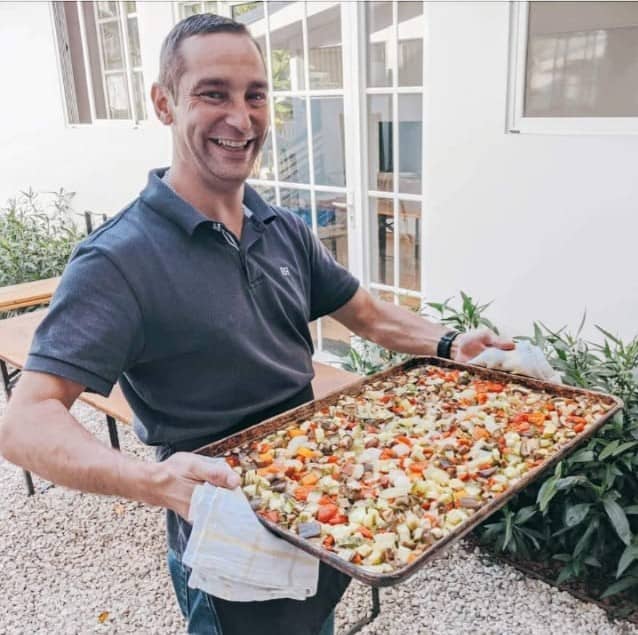
Staff cost is one of the highest, along with rent and food inventory, that you will have to endure as a coffee shop owner. It will take a significant toll on your monthly sales and be determinant on the level of customer service and food quality that you will have.
Unfortunately, there is no quick answer or formula to determine how many employees you need to start. However, I would say this:
The number of employees you hire depends on many factors like opening hours and number of shifts, type of service (table service or counter), whether you produce your food or not, number of tables and chairs, and others. According to Colin Harmon, you should aim for 25 to 40% of staff cost per expected net sales. We started with two employees and moved on from there.
Let us discuss in this article the following factors to consider when determining the number of employees to hire:
- Complexity of menu
- Type of Service
- Functions required
- Workflow organization
- Opening hours, opening days, and number of shifts
- Opening hours, opening days, and number of shifts
1. Complexity of menu

Is your menu simple or complex? This is one of the first aspects to consider when thinking about how many people to hire. For example, it will most definitely not be the same amount of people needed for ensembling sandwiches than cooking full meals.
If you have desserts or pastries, are you making them yourself or your staff, or are you buying finished products? There are pros and cons to each.
For example, when you make your own products, you can get creative, control quality, manufacture on-demand, and probably gain more from each item sold.
However, when you buy from someone else, you are not incurring in staff cost to manufacture. You need lees inventory and space; therefore, rent could be cheaper. You will probably gain less brute margin, but be careful, as the final net gain could be higher.
Another con of buying premade is that you depend on your supplier availability for restocking. You could also have a more significant wastage if orders are not sold.
So back to the point of employees. If you are making sandwiches, you will need one person to do this task. This person will also need to be restocking, washing vegetables, cutting, and organizing the table for the sandwich making.
Also, probably some heating or preparing the items for delivery will be required. However, suppose you are doing more elaborated dishes, like lasagna. In that case, a person making lasagna would also have to cook the pasta, the meat or chicken, and elaborate salsas. It becomes much more complicated.
It also reduces the chance that the person cooking can even go outside to deliver the meal to customers if necessary, because this person will most likely need to be in the kitchen. So the more complex your food menu is, the more staff you will need.
We started with just two people and me, so three people in total. The foods we served were sandwiches and salads. We bought the chicken pre-cooked because we did not want to introduce raw chicken to reduce the possibility of cross-contamination.
Outside of the operation, someone elaborated the more complex ingredients like caramelized onions, baked vegetables, and baked chili peppers. The staff was required to stock the refrigerated table, wash and cut vegetables, and ensemble the sandwiches according to a given recipe. That was it.
After some months, we understood the operation’s complexity in terms of time, workflow, and customers’ volume. We also realized that staff had some slow times during the day where they could afford to elaborate compound ingredients. So we evolved to the team making these ingredients.
We decided to keep buying the prebaked chicken to avoid raw meat. And in the end, we were left with an equilibrium of both: we bought some premade ingredients because of food safety criteria, and we started preparing others.
Another critical aspect of the complexity of the menu is how large your menu is. Not only because of inventory necessary but also for simplicity for making the products.
It is far easier to dominate making six sandwiches then twelve, for everyone. For the person taking the order, the one making it, and then charging for it. In general, the leaner your operation is, the less staff you will most probably require.
2. Type of Service

This is also determinant of the amount of staff you need to hire. It is not the same to have a type of service of ordering at the counter then ordering at the table, or both.
When we first started out, we hanged a sign that said “order here.” We did this out of the assumption that people would go inside our coffee shop, see the sign and go straight to the bar to order. This would save us needing to have someone to go to the tables and take orders. Boy, were we wrong.
I would say most people coming inside just missed the sign. Some went to the bar to see the menu and order, but others would sit at a table and wait for someone to take their order.
Given this situation, we had two choices: start taking orders at the table or find a way for customers to understand our intended service level. What do you believe happened? ended up adapting to our customers instead of the other way around.
Was this the right or wrong turnaround? We are not sure; But it seemed so, for the layout of our coffee shop did not make it easy for people to understand that we wanted them to order at the bar, and we were eager to please customers.
Although this could be beneficial to customer service, it added a layer of complexity to our operation: the need to know when someone walked inside and did not announce themselves. It also meant that now we needed an extra pair of hands to take orders and deliver food to the table.
It also gave something else, the possibility of people leaving their account open and ask for more items. So it had its cons and pros.
Another aspect that influences your coffee shop is if it has indoor seating or is for take-out, if it has a drive-through or not.
Each coffee shop has its characteristics; no one recipe fits all. But thinking about this helps to determine how much staff is required.
3. Functions required

In a coffee shop, you will mostly require a barista to make coffee. For coffee shops, this is highly important because of the quality of the drinks. It also gives a lot more seniority to your coffee operation.
However, some baristas will feel that they should not perform other tasks like cleaning or serving tables. If you have a barista with these beliefs, this will certainly make you need to hire more people.
The best thing to do is to have one or more baristas, but have them train other personnel to be substituted if necessary.
The other way around is also right. Baristas should perform other tasks to take over other employees, even if they are out of the scope of a barista. This is a dedicated team game player. You need them to be able to step up to the needs of the coffee shop.
Other types of functions you will need, besides a barista, are the following:
- Someone to ensemble or cook food items
- Someone, or yourself, to do administrative tasks like order from suppliers, track inventory, pay for salaries, and pay suppliers.
- Someone to charge bills to customers
- Someone to develop systems and supervise they are met
- Someone to wait tables
- Someone to do cleanings like wash dishes, tables, and clean toilet
- Someone to track sales and develop and execute marketing campaigns
- Other tasks depending on coffee shop characteristics
All this, and more, are tasks that will be necessary to do in a coffee shop. It can be quite intensive.
You do not necessarily need one person for each task. One person can perform several tasks. If your barista can handle other tasks, like waiting tables, you will maximize your human resources.
Also, if the same person who is waiting tables can wash dishes (if the time frames allow it), less employees are needed hiring.
Try to understand the tasks that need to be done at a particular time of the day. Then distribute the tasks around people and evaluate.
As an owner, you will probably want to control the more sensitive financial aspects like cost control and payment to employees and suppliers. But only when you start will you know what is needed. So do not be afraid to make adjustments along the way.
4. Workflow organization

Another crucial aspect is the workflow organization.
I once went to a coffee shop that had a great location and exceptional products. It was first a bakery that then turned into a coffee shop. It immediately became a sensation. However, the service was not good. Why? It had no workflow organization at all.
When I went there, I had to stay in line to order a smoothie. I had about 3 customers ahead of me ordering pastries. The bar was organized so that first you had the pastries and afterwards you ordered everything else.
But the problem with it was that if you only wanted to order a drink, you had to wait for people to order the pastries. The items had no signs, so the person attending had to explain each one to the customers. This caused long ques. The ones behind had to wait until the customer made its mind. Finally, the person would decide and then moved on to the cashier to pay and receive the food items.
While I was waiting in line for pastries, I asked: “If you want a drink and no pastries, should I still make the line? And the answer was yes, everybody has to make the line.
So I just waited as patiently as possible while my two-year-old was running up and down, and I was trying to make him stay still. Simultaneously, I saw four more employees behind the bar, apart from the one taking orders from clients.
One of them was waiting to charge customers but doing nothing at the time because no customers had arrived yet; they were all waiting in the pastry line. The other three were chatting amongst themselves. I could not help but think that one of those three people could make my smoothie while customers upfront decided on pastries.
Anyway, when it was my turn to give my order, I said: okay, I do not want a pastry, just a drink. And the girl said, “drinks are ordered at the cash registered.” I immediately said: “you made me make the line to tell me this”? For which again, she replied: yes there are ordered at the cash register, but you still have to make the whole line.
At that point, my frustration increased and at the same time, my two-year-old did not stop running back and forth.
Finally, did I mention that this happened after first we were told that our order will be taken at the table but no one ever arrived? So we decided to order for take-out and go to the bar.
What an incredible example of a workflow with efficiency opportunities. There were five employees behind the bar, and I saw at least another 7 people inside the kitchen. So at least 12 people on the operation.
I could not help but wonder how many sales that coffee shop needed to be able to maintain all that staff. It seemed to be selling a lot, and I was happy for them, but I could not help think that they were also leaving so much money on the table.
And I am not saying that we were doing things great, it is easy to judge from outside at other’s operations without looking for opportunities on your own business.
But at that particular day, I, as a customer, felt frustrated at the service I was given, with no care about my needs with my two-year-old son, and having to wait first at the table and then at the bar for over twenty minutes to order a drink.
What frustrated me the most was seeing so many staff just waiting for things to drop by instead of proactively seeking to attend customers.
Finally, I saw the owner giving instructions in the kitchen for a particular food item. The products were unique, the quality could not be better. But the lack of service made it all go to another direction, and I wanted so bad to go to the owner and tell him this and help.
Why do you need five people behind the bar? Especially if food is prepared somewhere else? And especially if customers are in a queue? At that particular time, if it were up to me, I would have tried the workflow of three people: one for pastries, one for drinks, and one at the cashier.
As Collin Harmon says in his fantastic book, What I know about running coffee shops: Monitor staff costs very well. Above 40%, you probably have people doing nothing. Below 25%, you may start to deteriorate food quality and service because staff can not keep up.
So first, after some trial runs, try to optimize your workflow. And then, see how much staff you actually need.
5. Opening hours, opening days, and number of shifts

This is also determinant to the amount of staff you require.
It is not the same to be open from early morning to late at night, where you will need at least two shifts, then if you are open for a single 8-hour shift.
If you decide to have two people per shift, and then you have two shifts, this will automatically multiply your staff number.
Coffee shops usually battle with lunch hours being slow. So, some coffee shops open in the morning, close, and then reopen for the afternoon. This can decrease your staff cost, but it can also make it more difficult to find people willing to have big breaks in their shift.
Another option could be to hire part-time. As this can solve the latter issue, it can also mean having less stable staff in the long run, as part-time employees are usually studying, aiming for other jobs, or have other commitments.
So determining this aspect is another crucial for choosing the right amount of staff needed.
We tried to understand customers’ possible flow at the beginning by conducting a small market research test. We learned that for that area during the mornings, the flow of customers was minimal. We also learned that Mondays were not worth opening.
With this being said, we decided to open from Wednesday to Sunday for a starting point, and from 11 a.m. to 7 p.m.
This meant we would have one shift only of full-time employees.
After some time, we changed it, but only when we grew sure that we wanted to expand our opening hours and open Tuesday to gain an extra day of sales. This meant hiring a third person, myself woking some days, and mixing shifts and schedules not to extend shifts but to cover more days and hours.
However, as a starting point, we started smaller, learned, and then increased.
6. Traffic Flow, net sales, and average ticket sale

Okay, so now we are talking. Here comes one of the trickiest parts.
If you have more volume of sales, you will need more staff.
Quoting Harmon again, he mentions keeping it between 25 to 45% of staff cost to net sales. Remembering the word “net” is crucial. It means you should subtract all taxes from the sales, and be sure to add all costs related to staff like paying holidays or health insurance for example.
The tricky part about this is that sales can vary depending on the day of the week and the time of the day. How do you determine when you need more people?
This requires the analysis of you as an owner by observing the behavior of your employees and customers. Does the atmosphere feel under control and relaxed, or does it feel overwhelming and out of control? Is there a peak of customers arriving at a specific time of the day and having the rest of the day with a low customer volume?
As said before, if customers start to complain, queues increase, customer service declines, as well as product quality, then first consider if there is something to improve regarding the organization of the workflow, and then analyze if you need more staff.
The other way around can also happen: if you consistently have low sales volume during a prolonged time, like weeks or months, you see employees with lots of spare time; then maybe it is time to let someone go or ask for partial shifts.
Unfortunately, there is no exact formula for this, but more of intuition.
As Hamon says in his book, when you decide to hire someone, you will probably have left overtime for a while as sales volume starts to increase.
The big question is, what comes first? First, hire more staff to increase customer service and product quality, and hence comes more sales volume? Or the other way around, you hold on until you have more sales volume to justify hiring someone else?
This is the intuition from you, the owner who has to decide, influenced by the level and standard of product quality and customer service and the flow of cash you can endure.
Regarding the average ticket per customer, it is not the same to serve many people who consume little than to serve a few people who consume a lot. From my perspective, it is far better to have a higher average ticket because you make more money from each person serving a particular customer.
I hope that with all this said above; you have a greater sense of how to calculate the number of employees you will need for your coffee shop.
References:
Matzen, Tom; Harrison, Marybeth. 2011. Start and Run a Coffee Bar. Self Counsel Press Business Series. 4th edition.
Harmon, Colin. 2018. What I Know About Running a Coffee Shops. Progressive Coffee Ltd .
